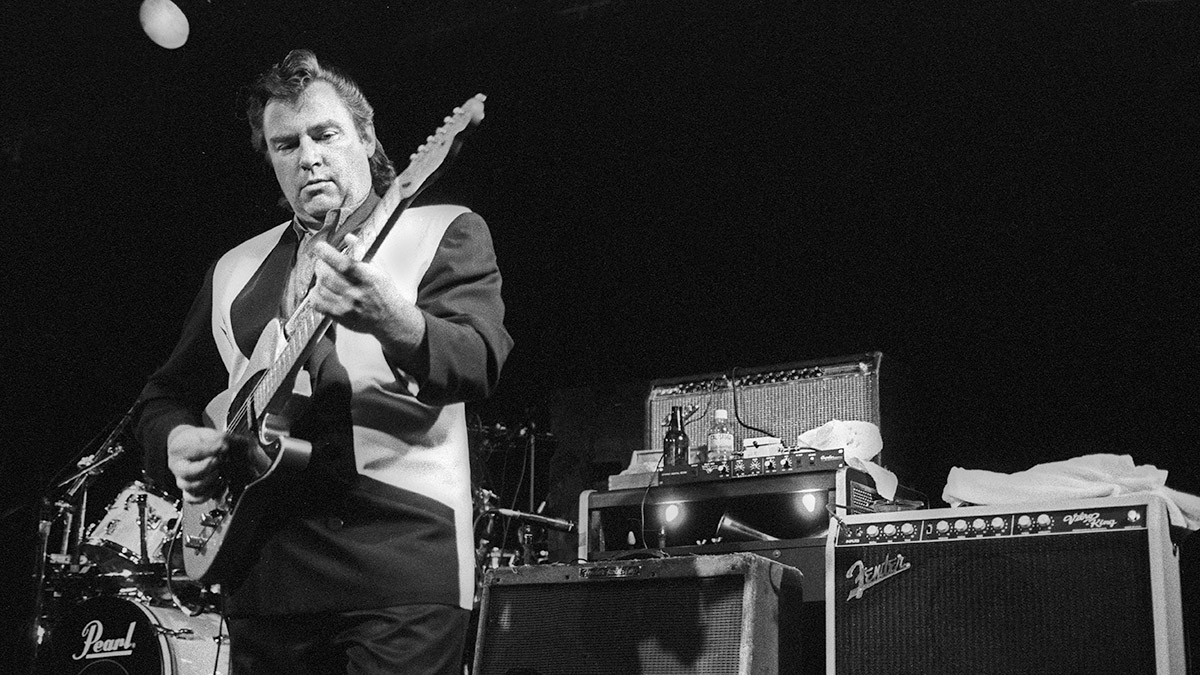Learn the licks of 6 guitarists who defined country guitar playing
Featuring Danny Gatton, Eldon Shamblin, Roy Clark, Chet Atkins, Jimmy Bryant and the inimitable Hank Garland, welcome to cowboy bootcamp for country guitar

The electric guitar is one of the key instruments in the country music ensemble, providing as it does the backbone of the groove and often playing exciting single-note solos. Country guitar is a blend of many styles including, jazz, blues, cowboy, swing and gospel styles.
In this feature, we will focus in on three core picking techniques with a view to developing the facility required to play some hot country lead guitar. The first of these is flatpicking, the country name for picking with down and up (alternate) pick strokes.
The second is fingerstyle. Country guitarists often add a thumb pick as this accentuates the attack for the bass notes. The third technique is the country guitar favourite, hybrid picking. Hybrid picking combines the advantages of using the flat pick (plectrum) along with the extra facility and tone of the fingers.
To provide inspiration for our studies we have identified six highly influential country giants. We have written a one-page study piece in the style of each of our players, which puts a spotlight on the key aspects of their style and also provides an opportunity to work on one of the three picking techniques just discussed.
First up is Eldon Shamblin who remains one of the most influential guitarists in the western swing style. Shamblin used an early prototype Stratocaster given to him by Leo Fender for much of his career.
Our second axeman is ‘Mr Guitar’ Chet Atkins. Chet was a country guitar virtuoso and often used a thumb pick to accentuate the bass note attack and provide extra fingerstyle dexterity.
Next up is Jimmy Bryant, often cited by Albert Lee as an influence. Bryant regulary recorded with pedal steel wizard Speedy West and the recordings of Speedy and Jimmy in action are jaw-dropping.
Our fourth guitar slinger is Hank Garland who recorded as both a jazz guitarist and in the country style (he’s the ‘land’ in Gibson’s Byrdland archtop). For this feature, we’ll focus on his country style output with a piece inspired by songs like Sugarfoot Rag.
Next up we take a look at the lightning fingers of Roy Clark. Clark often fused surf style spring reverb with devillish rockabilly licks and our piece is inspired by tracks like Texas Twist.
Our final player is country picking genius Danny Gatton. Gatton was a master of using hybrid picking (pick and fingers together) and our performance track turns up the heat to provide an uptempo workout.
Modern country players often tip their hats to our six trailblazers so it’s worth checking out how they affected later players such as Brent Mason, Mark Knopfler, Albert Lee and Nashville session ace, Tom Bukovac.
Technique Focus: Practicing the swing feel
One of the areas to develop in your quest to play country is the ability to play with a swing feel. The swing groove template is in 4/4 with a heavy accent on beats two and four. So it’s essential when playing the four-in-a-bar rhythm pattern (four crotchet down strums in a bar of 4/4) that these beats are accented. The second element is adding swing to quaver passages in lead lines.
You can practise this with alternate picking (down, up, down, up) and you should aim for a smooth and even sound. The amount of swing you add is down to personal preference and is often dictated by the rhythm section and groove of the song. Many jazz and swing players work on their time feel by practising swing with the metronome set on beats 2 and 4.
Making the spaces between the clicks larger requires more work from your internal clock and develops good time keeping. This approach also adds a natural accent to beats two and four. You may find it hard to practice this way to start with as most people will find placing the accent on beat two and four trickier than on beats one and three.
Get the tone
Amp Settings: Gain 3, Bass 7, Middle 6, Treble 9, Reverb 0
These ideas can be played on any type of guitar (most of our six used archtops). The classic country guitar lead tone uses the bridge pickup, with the amp set to a bright, clean tone and the reverb turned off. A compressor or clean boost can even out the picking attack. Use slapback echo set to a single short repeat, with the repeat volume just about as loud as the note you play.
Example 1. Eldon Shamblin
Our first track is designed to develop your flatpicking technique. All of these lines are played with alternate picking (down and up strokes). The licks are tailored to fit each chord. Bar 11 features the classic swing guitar technique of hammering onto a note from a semitone below (here, the b3 and 3 notes - Db and D - over Bb7).
Example 2. Chet Atkins
For our second track, we are focusing on using a thumbpick to play a fingerstyle accompaniment pattern. It will also work fingers only, but the pick provides extra attack for bass notes. If you are new to this general picking style then we’d recommend isolating the bass pattern.
A light palm mute will thicken the attack and this works well when combined with some slap-back echo. Once the bass line is memorised why not set a super slow metronome tempo and practise the technique, aiming to make it accurate, in-time and natural sounding. It may take practice to get up to performance tempo, but the results will be worth it.
Example 3. Jimmy Bryant
For this look at hybrid picking, play the notes on the third string with a pick downstroke, and the notes on the first string using the picking-hand’s third (or second) finger. The repeating phrase in bars 6 to 9 is created by a third string down stroke and a hammer-on followed by a third string finger pluck of the first string.
Example 4. Hank Garland
Here’s a slightly more demanding workout for your flatpicking. The melody is modelled around the form of a country rag and mostly uses the C major pentatonic scale (C-D-E-G-A). [Bar 11] features the technique of sliding into double-stop 3rds, which is a classic country guitar trope.
Example 5. Roy Clark
Our fifth piece uses the low register to great effect. The bridge pickup selection here is essential. Dig in hard with the pick and snap the strings to provide that country twang. Hear the rockabilly influence in [bar 17]! This type of fast descending run down the open position E blues scale (E-G-A-Bb-B-D) is classic rockabilly fare.
Example 6. Danny Gatton
Here’s a hot picking showstopper! Hybrid picking is great for playing these types of parts. We have notated the picking pattern which is the same throughout. First, play a palm-muted down stroke with the flat pick. This is followed by a plucked double-stop using second (m) and third (a) fingers, then a hammer-on.
A variation is to play the downstroke bass note followed by the double-stop with a pull-off. Begin slowly to avoid practising mistakes at speed too soon!
Get The Pick Newsletter
All the latest guitar news, interviews, lessons, reviews, deals and more, direct to your inbox!
Jon Bishop is a UK-based guitarist and freelance musician, and a longtime contributor to Guitar Techniques and Total Guitar. He's a graduate of the Academy of Contemporary Music in Guildford and is touring and recording guitarist for British rock 'n' roll royalty Shakin’ Stevens.
“The future is pretty bright”: Norman's Rare Guitars has unearthed another future blues great – and the 15-year-old guitar star has already jammed with Michael Lemmo
“I said, ‘Mike, I don’t know how to tell you this, but that’s a note-for-note guitar solo from...” Mike McCready stole his Alive solo from Kiss – but Ace Frehley had already stolen it from another legendary classic rock band













![Joe Bonamassa [left] wears a deep blue suit and polka-dotted shirt and plays his green refin Strat; the late Irish blues legend Rory Gallagher [right] screams and inflicts some punishment on his heavily worn number one Stratocaster.](https://cdn.mos.cms.futurecdn.net/cw28h7UBcTVfTLs7p7eiLe.jpg)


